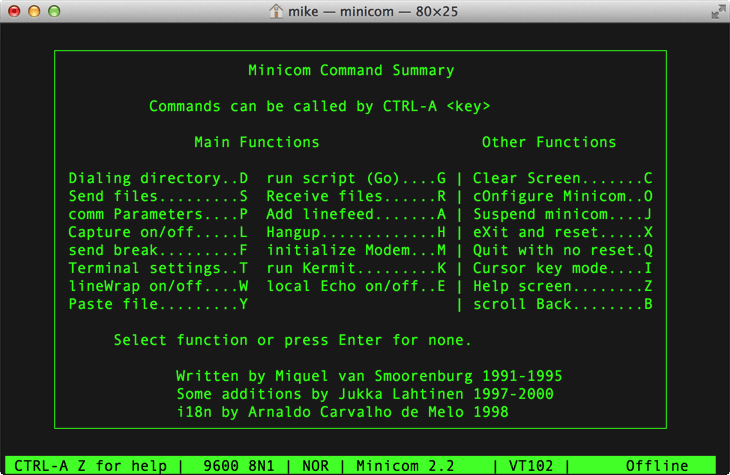

Minicom -ow -D /dev/ttyUSB0 īut if you've followed the steps of the previous section and saved your configuration under "ttyUSB0" (file "~/.minirc.Minicom is the next common serial debugging tool for Linux. You can now run minicom with your new configuration :Ī simple way to start minicom is, as regular user : Note that you must exit minicom ("Ctrl-a" and "q") in order to use the new configuration. Q -> 8N1 (8 data bits, No parity, 1 stop bit) The most common modifications to the configuration are the following ones :Ī -> /dev/ttyUSB0 Į -> Bps/Par/Bits Most of the time, when you start minicom for embedded system development, the default configuration is not appropriate. ), you can simply copy the "~/.minirc.ttyUSB0" file and either use minicom menu or edit the copy directly and change the "pu port" line to get the same config for these other ttys. Now, to create many configurations (say, for ttyUSB1, ttyUSB2, ttyACM0. Make the required changes to your configuration (see below), and use this menu entry to save your configuration. and instead of "Save setup as dfl" you get "Save setup as ttyUSB0". You can now configure minicom by hitting "Ctrl+a" and "o". Run minicom with this config name (the tty must be present, plug your USB-serial adapter if it's not the case yet) : I'm using "ttyUSB0" as the config name for the "/dev/ttyUSB0" tty as I feel like it's easy to remember, but the config name can be anything you would remember. Of course, you can try to create your config manually by looking at examples in /usr/share/doc/minicom/examples or looking over the web for sample configurations, but there's a much more simple way. When you run minicom with a configuration name, for example "minicom my_config" then minicom will also look for a configuration file named "$HOME/.minirc.my_config". but that's not an excuse to do things the wrong way) Indeed, one option is to run "minicom -s" as root, change the configuration, and "Save setup as." to store the configurationīut this will create system-wide configurations (Ok, you may be the only user of your system. Then you may want to be able to store new configurations. Store / modify configurations as normal user So if you are already logged in a graphical session and do not want to logout and login back, you can simply use the command "su username" in a terminal to get a new session in which you are in the dialout group for the current session and have access (in this terminal) to the ttys which are in the dialout group. This will only be effective for the next login of the user "username". This, of course, is done by the system administrator (root or any user allowed to run the adduser command) : Well, this part is not really minicom configuration, but it has to be done to use minicom as normal user, so here it is :) 1.2 Store / modify configurations as normal userĪllow normal users to access ttys and store configurationsĭespite what you will read on many places : you do not need to be root to run or configure minicom !!! (but you will need a well configured system).įirst, you must add the users which should be allowed to run minicom to a group with read and write access to the ttys you want to use, which are most of the time under the "dialout" group (ttyS*, ttyUSB*, ttyACM*.1 Allow normal users to access ttys and store configurations.


 0 kommentar(er)
0 kommentar(er)
